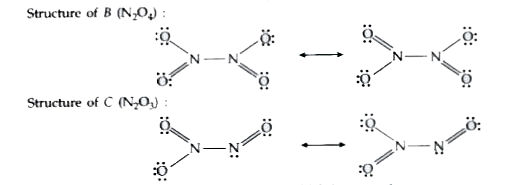On heating lead (II) nitrate gives a brown gas "A". The gas "A" on cooling changes to colourless solid "B". Solid "B" on heating with no changes to a blue solid 'C'. Identify 'A', 'B' and 'C' and also write reactions involved and draw the structures of 'B' and 'C'.
The gas A is NO2.
The reactions are explained as under :
2Pb(NO3)2Δ−−→673K2PbO+4NO2 A (Brown colour)+O2
2NO2On cooling −−−−−−→N2O4(Colourless solid)
2NO+N2O4B250K−−→2N2O3C (Brown colour solid )
Structure of B (N2O4) :

Topper's Solved these Questions
- THE P-BLOCK ELEMENTS BOOK - U-LIKE SERIESCHAPTER - THE P-BLOCK ELEMENTS EXERCISE - SELF ASSESSMENT TEST ( SECTION A)
7 Videos
- THE P-BLOCK ELEMENTS BOOK - U-LIKE SERIESCHAPTER - THE P-BLOCK ELEMENTS EXERCISE - LONG ANSWER QUESTION-I
56 Videos
- THE D-AND F-BLOCK ELEMENTS BOOK - U-LIKE SERIESCHAPTER - THE D-AND F-BLOCK ELEMENTS EXERCISE - SELF ASSESSMENT TEST (SECTION A ) MULTIPLE CHOICE QUESTIONS (CHOOSE THE CORRECT OPTION)
7 Videos
Similar Questions
(a) When concentrated sulphuric acid was added to an unknown salt present in a test tube a brown gas (A) was evolved. This gas intensified when copper turnings were added to this test tube.On cooling the gas (A) changed into a colourless solid (B). Identify (A) and (B). Writen chemical reactions involved.
(b) Drawn structure of XeOF4.
View Solution(a) When concentrated sulphuric acid was added to an unknown salt present in a test tube a brown gas (A) was evolved . This gas intensified when copper turnings were added to this test tube . On cooling, the gas (A) changed into a colourless solid (B) .
(i) Identify (A) and (B).
(ii) Write the structures of (A) and (B).
(iii) Why does gas (A) change to solid on cooling ?
(b) Arrange the following in the decreasing order of their reducing character :
HF , HCl , HBr , HI
(c) Complete the following reaction :
XeF4+SbF5→
View Solution
Knowledge Check
Lead nitrate on heating gives A, A on cooling give B, NO with B give C(blue solid). Find oxidation no of N in compound C
A1B2C3D4
(a) When concentrated sulphuric acid was added to an unknown salt present in a test tube a brown gas (A) was evolved . This gas intensified when copper turnings were added to this test tube . On cooling, the gas (A) changed into a colourless solid (B) .
(i) Identify (A) and (B).
(ii) Write the structures of (A) and (B).
(iii) Why does gas (A) change to solid on cooling ?
(b) Arrange the following in the decreasing order of their reducing character :
HF , HCl , HBr , HI
(c) Complete the following reaction :
XeF4+SbF5→
View SolutionLead nitrate on heating gives A, A on cooling give B, NO with B give C(blue solid). Find oxidation no of N in compound C
View SolutionAn orange solid a on heating gave a green residue B, a colourless gas c and water vapour. The dry gas c on passing over heated Mg gave a white solid D. D on reaction with water gave a gas E which formed dense white fumes with HCl. Identify A to E and give the reaction involved.
View SolutionWhen conc. H2SO4 was added to an unknown salt present in a test which was heated, a brown gas (A) was evolved. The gas intenstified when copper turning were also added into the test tube. On cooling, the gas (A) changed into a colourless liquid (B).
(a) Identify the gases A and B
(b) Write equations for the reactions involved.
View SolutionA colourless solid A on heating gives a white solid B and a colourless gas C, B gives off reddish brown fumes on treatment with dilute acids. On heating with NH4CI B gives a colourless gas D and a residue E.
The compound A also gives a colourless gas F on heating with ammonium sulphate and white residue G. Both E and Gimpart bright yellow colour to Bunsen flame. The gas C forms white powder with strongly heated magnesium metal. The white powder forms magnesium hydroxide with water. The gas D, on the other hand, is absorbed by heated calcium which gives of ammonia on hydrolysis. Identify the substances A to G and give reactions for the changes involved.
View SolutionCaCO3 on heating gives a white solid (A) and a gas (B), (A) on heating with carbon gives a solid (C) and a gas (D), (C) on hydrolysis glves a gas (E) and a solid (F) Identify (A), (B), (C), (D) , (E) and (F) .
View SolutionAn orange solid (A) on heating gave a green residue (B), colourless gas (C) and water vapour. The dry gas (C) on passing over heated magnesium gave a white solid (D).(D) on reaction with water have a gas (E) which formed dense white fumes with HCl. Indentify (A) to (E) and give the reactions.
View Solution
